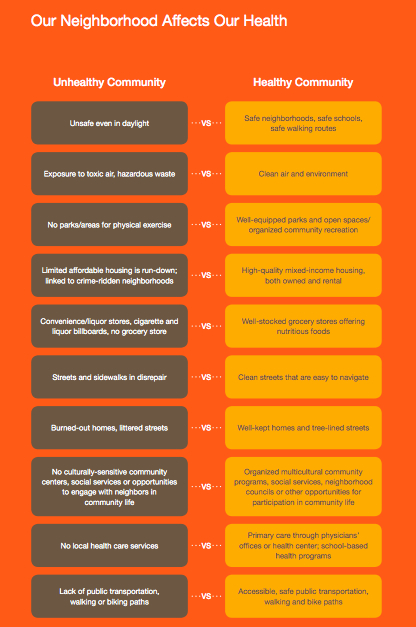Designing Better Health Practices for all Americans
June 1, 2009
Note: To see a larger view of the chart, download the Executive Summary and go to page 11. The size of the chart is predetermined by the constraints of this blogging template.
About three months ago, I met a woman who was concerned about starving children -- not the ones that we see on television -- but in our own nation, the U.S. I often wonder how, in a nation as rich as ours, we continue to have individuals and families that aren’t eating enough while others seemingly eat more than they need?
The Robert Wood Johnson Foundation (RWJF) has been asking a similar question through the
About three months ago, I met a woman who was concerned about starving children -- not the ones that we see on television -- but in our own nation, the U.S. I often wonder how, in a nation as rich as ours, we continue to have individuals and families that aren’t eating enough while others seemingly eat more than they need?
The Robert Wood Johnson Foundation (RWJF) has been asking a similar question through the
Commission for a Healthier America since February 2008. In
Reaching America’s Health Potential: A State-by-State Look at Adult Health, they show that 45.2 percent of American adults, ages 25-74, report being in less than very good health and how having higher levels of education -- a college degree -- statistically determined having better health.
In Beyond Healthcare: New Directions to a Healthier America, RWJF says being healthy is more than just having access to health care services. “Where people live, learn, work and play affects how long and well they will live.” Citing great multiple strategies, recommendations, and recognizing not-one-size fits-all communities, I was intrigued to read that they had identified “practical, feasible, and effective solutions,” at local, state and federal levels. But, because these solutions were isolated and scattered, they believed that these solutions would not have a broader effect on the health community at large. The report further says, “Until we reduce poverty and overall educational attainment, America cannot and will not be as healthy.” While this may be true, it will be a longer time before most of our population has a college degree. Presently, it is just over 25 percent (2006, US Census).
In contrast, I believe the “practical, feasible, and effective solutions” is exactly where on-the-ground human-centered design is needed. Individuals and families that fall statistically toward the end of the bell curve are being and doing something clever, innovative, and practical. Who are they? How are they achieving wellness? That is, there are people that have high school degrees, who live in middling communities and have lower incomes; yet, they are healthy and thriving. How might we learn from them and be informed by their practices? We may all benefit in the shorter term while higher-level comprehensive strategies move us toward a healthier nation.
In contrast, I believe the “practical, feasible, and effective solutions” is exactly where on-the-ground human-centered design is needed. Individuals and families that fall statistically toward the end of the bell curve are being and doing something clever, innovative, and practical. Who are they? How are they achieving wellness? That is, there are people that have high school degrees, who live in middling communities and have lower incomes; yet, they are healthy and thriving. How might we learn from them and be informed by their practices? We may all benefit in the shorter term while higher-level comprehensive strategies move us toward a healthier nation.
Posted by Renee Chin. Posted In : health and communities
 With an ever inquisitive and exploratory mind, I collaborate with forward-thinking people, ideas, and multidisciplinary teams. Who I work with are Fortune 500 or 1000s, think tanks, or boutique firms that aspire to extraordinary and actionable insights driven by human-centered or service-centered design. Marketing campaigns, new business ventures and product designers benefit from these insights. Understanding human behavior, language, and meanings elucidates how people really behave rather than what they say they do, or think, leading to products and services that better meet customers’ needs.
With an ever inquisitive and exploratory mind, I collaborate with forward-thinking people, ideas, and multidisciplinary teams. Who I work with are Fortune 500 or 1000s, think tanks, or boutique firms that aspire to extraordinary and actionable insights driven by human-centered or service-centered design. Marketing campaigns, new business ventures and product designers benefit from these insights. Understanding human behavior, language, and meanings elucidates how people really behave rather than what they say they do, or think, leading to products and services that better meet customers’ needs.